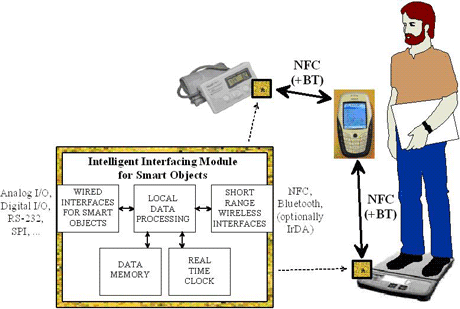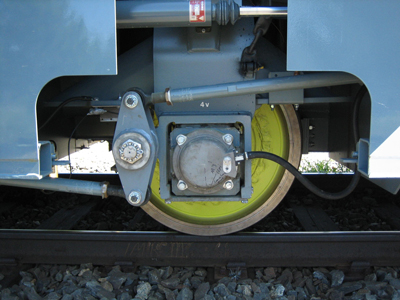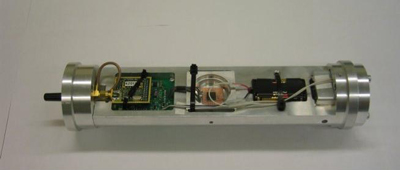by Mikko Sallinen, Esko Strömmer and Pirkka Tukeva
Short-range communication technology is proving its worth in many areas of application. Here we illustrate three case studies involving NFC (Near-Field Communication) and Nanonet radio technology. These include a consumer application with the TouchMe paradigm, and professional applications for force measurements on train wheels and acceleration measurements on the axis of a paper mill machine. We also show the advantages of these short-range communication technologies and discuss other potential applications.
In recent years, a rapidly growing range of wireless communication technology has become available and is being applied to numerous application domains. One of the latest examples of short-range communication technology is a light and simplified version of Bluetooth known as Bluetooth ULP (Ultra-Low Power), earlier known as Wibree. Other examples of short-range communication technology include RFID, Bluetooth, IrDA and Zigbee. From these technologies, IrDA and Bluetooth offer a huge number of applications.
New technology will also generate a new business for the service sector which is an important growing market. There are many areas in which wireless technology will find ubiquitous application, including entertainment, healthcare, automotive and logistics. These are areas which have a huge future market potential.
In industrial or other professional applications, the requirements for accuracy, reliability and timing are typically higher than in consumer applications. Current applications include measurement and wireless data transfer from the field to a central unit, as well as control and monitoring applications. In many cases this works well, but the problem is often that even if the data can be transferred, it is still necessary to have power cables. Energy harvesting and power management is one of the key issues in the more challenging industrial applications.
In this article, we use two different technologies. The first is NFC (Near-Field Communication), an RFID-based technology that provides short-range communication at 13.56 MHz licence-free band. The second is the Nanonet radio module, which uses the 2.4 GHz licence-free band and is manufactured by Nanotron Ltd.
Touch-based Sensor Readout by NFC
NFC can be used to read data from a sensor to a mobile handset by touching the sensor to the mobile handset. In more data-intensive sensor applications, NFC can easily establish a Bluetooth connection between two devices when they are brought close together. It is not necessary for a user to find the correct menu items and configuration parameters on the mobile handset, which makes interaction with the NFC-enabled sensor very elegant. On the other hand, the sensor must be within the reach of the user.
For easy piloting of NFC applications we have developed Smart NFC Interface, a building block that provides NFC and Bluetooth communication capability to various smart objects. Thus it also makes these smart objects capable of communicating with mobile handsets as depicted in Figure 1. Smart NFC Interface incorporates components for short-range wireless communication with mobile handsets, a set of wired interfaces for sensors and other smart objects, local data processing and storage, and a clock for time stamping the measurement results and other events.

The advantages of NFC over alternative wireless short-range communication technologies in sensor applications, such as Bluetooth, are its lower power consumption, shorter communication set-up latency and better immunity to eavesdropping. NFC can also operate in passive mode with extremely low power consumption, which means wireless sensors can have multiple-year battery lifetimes. Even batteryless sensors taking their power from the RF field that is generated by a nearby active NFC device are feasible.
In addition, NFC enables simple communication based on the TouchMe paradigm that from the user's viewpoint is fast and convenient compared to plugging in cables or manually establishing a Bluetooth connection between the sensor and the mobile handset.
Force Measurements on Train Wheels
A typical challenge in the industry is taking measurements on rotating machines. The difficulty of wiring both data and power supply makes this a non-trivial problem. Examples of this kind of object are wheels, turbines, blades and paper rolls. In this field, the goals are to optimize construction and maintenance by condition monitoring, and to be able to foresee the need for maintenance. It would be much more effective to carry out maintenance based on the actual wear of parts, rather than based on age as tends to be the case. In the future, this will lead to significant savings.

To take force measurements on train wheels, strain gauges are placed on the surface of the wheel in the form of a star. The measurements are converted using FPGA platform and then transferred using the 2.4 GHz ISM band and 2Mb/s wireless link. The power consumption while in use is 60 mA, and 1µA while in standby. Maximum transit power is 10 mW. The outdoor range of the radio is 100m; when indoors it depends on the presence of surfaces and walls. Communication with sensors is carried out using an SPI (serial peripheral interface) interface with a 16 Mhz line. This wireless link is carried out using NanoNET power modules by Nanotron.
Nanotron uses 'chirp' modulation technology, which provides benefits such as resistance to multipath fading. In the receiver side of the measurement system, the System-on-Chip platform receives the data. In each wheel there are twenty pairs of strain gauges that measure the deformation of the wheel. These strain gauges are read at a frequency of 3 kHz. The measurements are filtered to a frequency of 500 Hz and the data is transferred using 48 channels for transformation. It is therefore necessary to run several radios in parallel and to carry out high-speed synchronization. The sampling rate is 290 MHz in the developed system.
Acceleration Measurements from the Axis of a Paper Mill
In the third application, we integrated a 3D acceleration measurement system with the axis of a paper roll. The goal was to measure the acceleration of the axis and be able to predict cases in which the paper will tear in the paper machine. It is known that tear will occur when there is vibration in the axis. For this purpose, a specific measurement tool was designed (see Figure 3). It includes a triple-axis acceleration sensor and a transmitter to send online measurement signals. The challenge in the task was to successfully transmit a signal through a full paper roll. For the data transmission, we used the same radio technology as in the train wheel case; with this we were able to measure and recognize peaks in the vibrations of the axis and the data was transmitted successfully even through the thickness of the roll.

Please contact:
Mikko Sallinen
VTT Technical Research Centre, Finland
Tel: +358 40 7235263
E-mail: Mikko.Sallinen![]() vtt.fi
vtt.fi










